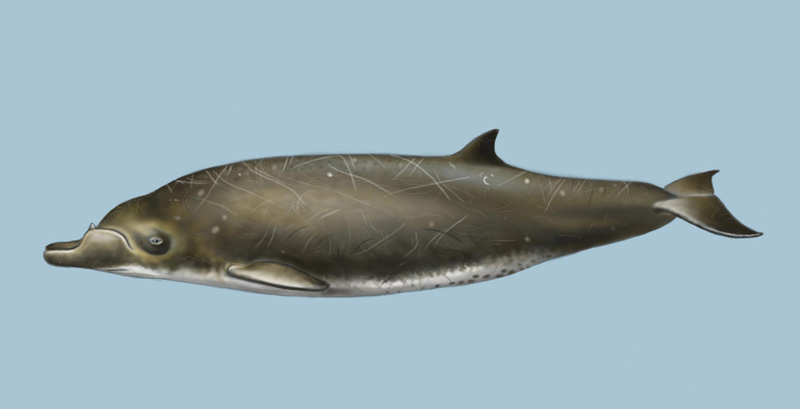Mesoplodon densirostris
IUCN
LCBasic Information
Scientific classification
- name:Mesoplodon densirostris
- Scientific Name:Mesoplodon densirostris,Bryde's beaked whale, Bryde's beaked whale, Blunt beaked whale
- Outline:Cetacea
- Family:Odontoceti B.Whale
Vital signs
- length:4.5-4.6m
- Weight:820-1030kg
- lifetime:No verification yet
Feature
The male Beaked Whale is one of the most bizarre looking whales in the world.
Distribution and Habitat
Distributed in tropical and mid-latitude areas of the Atlantic, Pacific, Indian, Mediterranean, Black Seas and other waters.
Origin (sea): Angola, Australia, Bahamas, Belize, Brazil, Cameroon, Canada, Cape Verde, Cayman Islands, Chile, China, Colombia, Comoros, Costa Rica, Ecuador, Fiji, Guam, Guatemala, Guyana, Honduras, India, Indonesia, Japan, Kenya, Cocos Islands, Kiribati, Madagascar, Malaysia, Marshall Islands, Mauritania, Mauritius, Mayotte, Micronesia, Morocco, Mozambique, Myanmar, Namibia, Nauru, New Caledonia, New Zealand, Nicaragua, Nigeria, Northern Mariana Islands, Oman, Pakistan, Palau, Panama, Papua New Guinea, Peru, Philippines, Portugal, Reunion, Saint Helena, Ascension Island, Tristan da Cunha, Sao Tome and Principe, Seychelles, Solomon Islands, Somalia, South Africa, Spain, Sri Lanka, Tanzania, Tokelau, Tonga, United Kingdom, United States, Uruguay, Vanuatu, Venezuela, Vietnam, Wallis and Futuna Islands, Western Sahara, Yemen.
In China, it is mainly distributed
Appearance
The average body length of males and females is 4.5 to 4.6 meters, and the average weight is 820 to 1,030 kilograms. The head is small, the beak is short, the forehead is low, and there is no crease between the beak and the forehead. The dorsal fin is nearly triangular, the tip is backward, and it is located about 2/3 of the body length from the tip of the snout. The flippers are small and narrow and can be collected into the bag-shaped shallow depressions in the body wall. The tail lobe is large, with a straight trailing edge and no notch in the center. The breathing hole is crescent-shaped, with the concave surface facing forward. There is a pair of "V" shaped throat grooves between the two mandibles. The back and ventral surfaces of the adult male are dark gray, with round or oval white scars and tooth marks on the body surface. Juveniles and female adults are medium gray dorsally and white ventrally. Only the adult male has one pair of functional teeth. The male adult has
Details
Blainville's beaked whale is the most common species in the genus Blainville.

Blainville's beaked whales usually move alone or in pairs, and small groups of 3 to 7 (occasionally up to 12) have also been recorded.
The beaked whale generally performs shallow dives, but can dive deep for up to 45 minutes. After a series of shallow dives with an interval of about 15 to 20 seconds, it will dive deep for another 20 to 45 minutes. When surfacing, the beak appears first and points straight up to the sky; after breathing, it sometimes slaps the sea surface and slowly rolls before disappearing. It is cautious by nature. The jet is small and not obvious, but it may be visible on calm days, and the air column leans forward. The scars indicate fighting between competing male whales, and there is also speculation that they are caused by attacks by killer whales or false killer whales.
The beaked whale mainly feeds on cephalopods of the families Squididae, Squididae, and Squididae. Of course, they are also likely to prey on other fish and invertebrates in large numbers.
P. paulii's beaked whales are polygamous. There is very limited information on the reproduction of P. paulii's beaked whales. It is estimated that both sexes mature at around 9 years of age. Females give birth to one calf per litter, and the calf is 1.9-2.6 meters long and weighs about 60 kilograms.
An estimated 2,138 (CV=77%) calves are found in Hawaiian waters (Barlow 2003). 106 beaked whales have been reported in the northern Gulf of Mexico (CV=41%), which may be a mixture of P. paulii's beaked whales and J. paulii's beaked whales (Mullin & Fulling 2004). Ferguson and Barlow (1999) estimated that there are 32,678 beaked whales in the eastern Pacific, mainly Peruvian beaked whales and Baird's beaked whales (Pitman & Lynn 2001).
Listed in Appendix II of the Convention on International Trade in Endangered Species of Wild Fauna and Flora (CITES).
Listed in China's "National Key Protected Wildlife List": National Class II Protected Animals (effective December 10, 1988, Cetacean * Other Cetaceans).
Listed in the "IUCN Red List of Threatened Species": Data Deficient (DD), assessed in 2008.
Listed in the second level of the "List of National Key Protected Wildlife in China".
Protect wild animals and eliminate game.
Maintaining ecological balance is everyone's responsibility!








